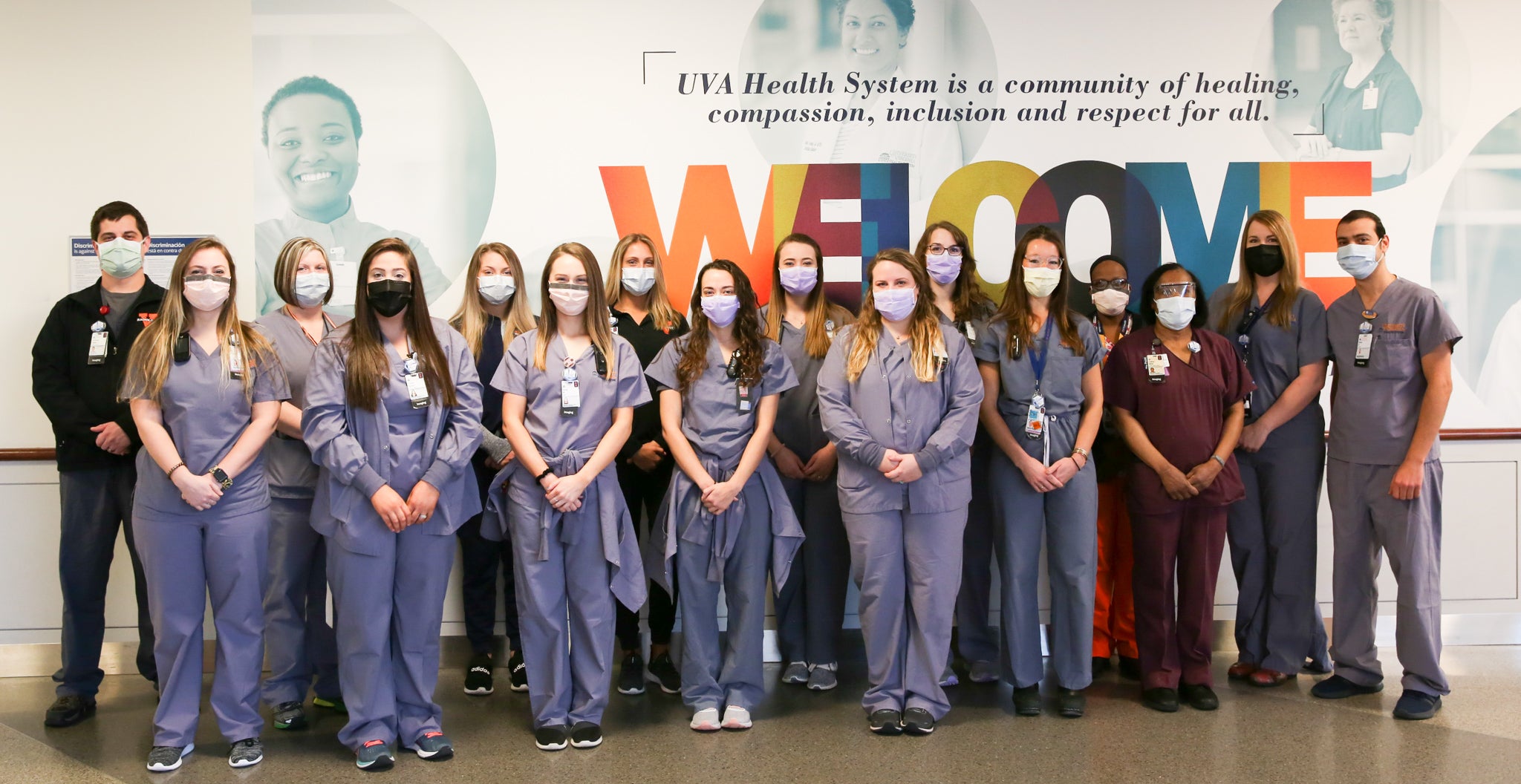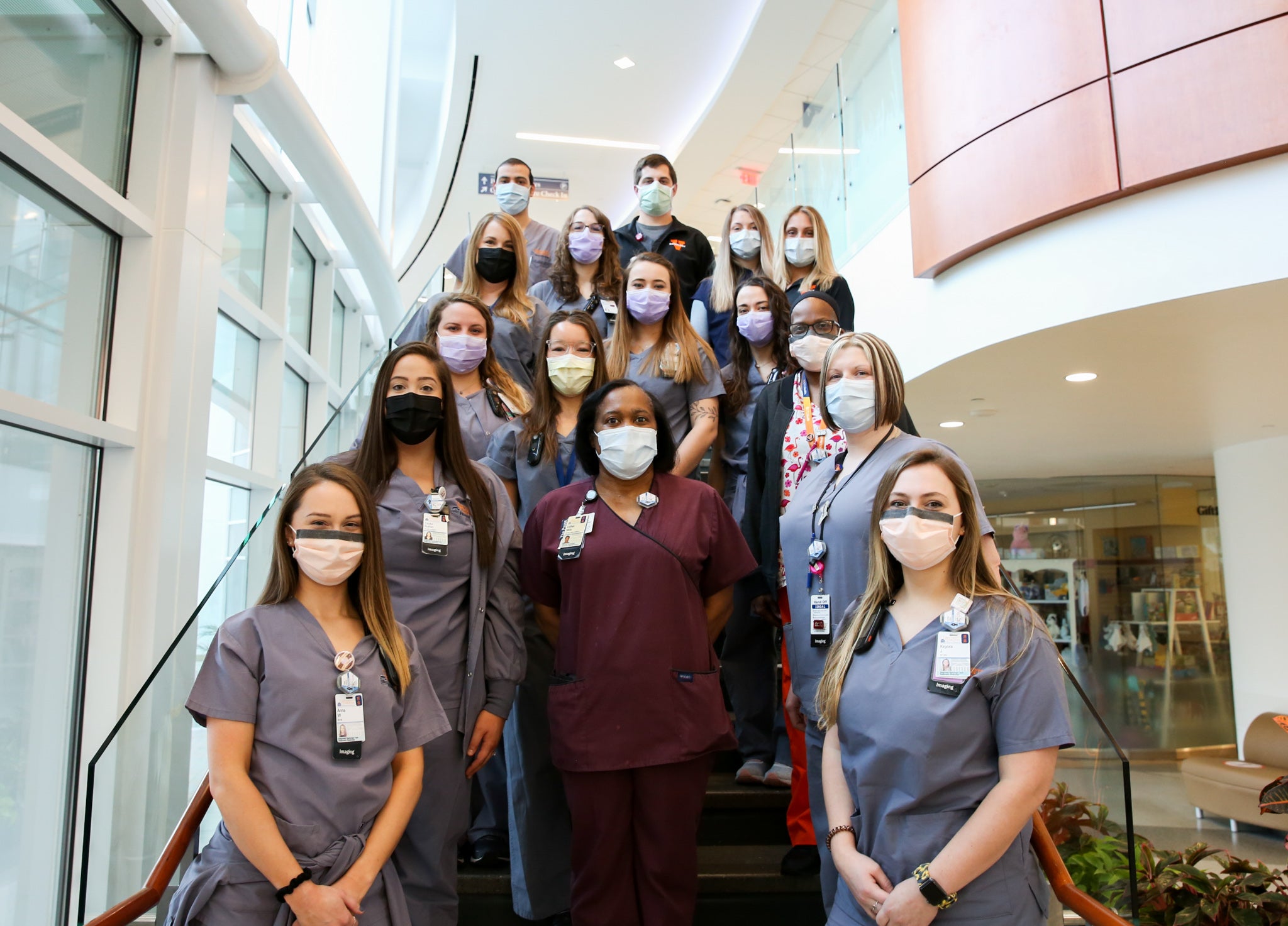
UVA Radiology Diagnostic Radiology Technologists stand before the mural in the UVA Health main lobby
Editor’s note: This is the second in a series of articles profiling different modality teams at UVA Radiology and how they’ve risen to the challenges of COVID-19. To read about the CT team, click here.
When most people think of radiology, they probably think of x-rays. After all, x-rays are the most commonly ordered imaging exam. And patients often think that it’s radiologists who are physically taking their x-ray images. But that’s not the case – the actual x-rays are taken by diagnostic radiology technologists, professionals who are specifically trained and educated to take many different kinds of x-rays of any part of the human body.
At the 631-bed UVA Medical Center, the 65-person Diagnostic Radiology team is responsible for just about every x-ray taken of patients inside of the hospital. From the smallest infants in the NICU to geriatric patients in the Transitional Care Hospital; routine scans of chests or broken bones to x-raying trauma cases in the Emergency Department; operating the C-Arm to provide real-time fluoroscopic imaging in the operating suites to using a portable unit that travels to every room in the hospital – diagnostic radiology technologists have to thrive in a remarkably diverse set of circumstances.
And they have to do it over and over again, every day, for every patient who needs images. It’s hard to think of any care providers at UVA who have to adapt to so many radically different circumstances.
“Diagnostic techs have to be jacks of all trades,” says Bob Hunsberger, who, along with Anthony Calise, is one of the two Diagnostic Radiology Supervisors. “We can’t just specialize in one thing – we have to go and image any and all patient populations. We immerse ourselves with everyone.”
The Scope of Care that Diagnostic Radiology Provides
Diagnostic radiology is a 24/7 service, 365 days a year. On an average day, diagnostic technologists might travel to 75 or 80 different rooms in the hospital to take x-rays on rolling, 1,300-pound portable imaging units. They’re responsible for getting the highest-quality x-rays of around 90 Emergency Department patients a day. Daily, they image 50-60 inpatients for morning rounds so physicians can assess how their patients are doing. And they are integral parts of dozens of surgeries in the Operating Rooms each day.
It’s a relentless and diverse volume, day in and day out. And the entire spectrum of care at UVA Health relies on the images that technologists produce. After all, each image offers critical insights on patients, insights that will help determine treatment, management and, ultimately, their health. It couldn’t matter more to each patient and their families. And it’s a responsibility diagnostic technologists take seriously.
“That’s the job,” says Calise. “Whoever comes in, whatever comes up, we don’t say no. We don’t turn any imaging request down. If a patient is in the building and needs an x-ray, we have to figure it out. Every single day.”
The New ‘Every Day’
Like every care team at UVA and hospitals across the globe, diagnostic radiology technologists have been impacted by the COVID-19 pandemic. Working alone instead of in pairs, and having to take significantly extra time donning and doffing protective gear before imaging patients has become a routine part of daily life. As have entering the COVID-19 wards and imaging COVID-positive patients.
“We are in the COVID wards and the Emergency Department all day, every day,” says Calise. “And as far as we know, no one on our team has contracted COVID-19 at the hospital. Masking and eye protection has worked. Plenty of people have been tested, but no one on our team has gotten COVID-19 from a patient.”
That’s a remarkable record of safety – all the more remarkable because diagnostic techs aren’t confined to one area of the hospital, but move through literally every space in the building, spending time in close quarters with countless patients. The last thing they want to do is bring COVID from one patient to another. That’s why the team takes safety and PPE extremely seriously.
“We’re like busy little bees,” says Diagnostic Technologist Gordon Songer. ‘If we’re not careful we’d pollinate the whole hospital, because we’re everywhere.”
Besides the challenge of protecting themselves and patients from COVID, technologists also face unique challenges in getting high-quality x-rays of COVID-positive patients.
“We’re taught in school to do portable chest x-rays with a patient sitting upright or laying flat on their back,” says Hunsberger. “But part of COVID-19 treatment is rolling patients prone with their back up, chest down. I might have done one or two prone chest x-rays in the last seventeen years, but now it’s a daily occurrence. So it’s a totally different approach for us.”

Solidarity and Perseverance
When Calise and Hunsberger think back to everything that their team has experienced, nearly one year into this COVID-19 pandemic, they are struck by the flexibility and solidarity they have shown.
At the beginning of the pandemic, like the other modalities in the department, they split the technologists into two groups. Each worked one week on, one week off, so that if there was a COVID-19 exposure only half the technologists would be exposed at once.
Calise saw the sacrifice that it took to make that new schedule work on only a few days’ notice. “It required mandatory overtime,” he says. “Some people who were only working a few days a week had to work full-time. Some people with multiple jobs had to juggle them and balance their time. We have to recognize the team for stepping up and working 6 days a week during that time.”
Hunsberger agrees: “When we cut the team in half when COVID started, and operated with half the staff and changed schedules, we only had two to three days’ notice for that. Our people stepped up and there was no issue with it. They adapted and were flexible. It was amazing perseverance through it all.”
Both Calise and Hunsberger also bring up the actions of one night-shift technologist, Gordon Songer, as an example of the kind of behavior that has so impressed them.
There was a very large COVID-19 exposure in the Pediatric Intensive Care Unit over the summer. Because of the sheer scale of the exposure, the Health System decided that all exposed employees would have to wear N95 masks at all times while in the hospital for a full two weeks.
All of Gordon’s night shift colleagues had imaged this patient, and so would have to wear N95s for two weeks. But because Gordon had not imaged this patient, he didn’t have to. That didn’t sit right with Gordon.
“It’s one thing to wear an N95 while giving patient care, and then be able to step out into another room and take it off and put on a different mask,” Gordon says. “But it’s really hard to wear all shift, even when sitting in an area with no patients around. It’s hot and hard to breath, and the bands are very tight because it needs to be tight to work.”
“I couldn’t be the only comfortable one on the team. There was no way. So I wore the N95 for those two weeks, too, to show my solidarity and support for my team.”
Prepared To Thrive in Challenging Times
Hunsberger is proud of his team but not surprised that they have persevered during this difficult time. To him, the skills and qualities that COVID-19 has demanded of all of us are the same ones that make a good diagnostic technologist. He says:
“We’re always asked to make the best of any situation. And we do. That’s kind of the gist of being a good diagnostic technologist: taking the situation you have, whatever it is, and being able to produce high-quality images in less than high-quality situations.”
“There’s nothing our team is not capable of doing, if we ask them.”

To my former colleagues, Diagnostic Radiology Technologists, I am so thankful for your dedication. Anthony and Bob, keep up the good work! Hard work, respect and unity will surely pay off. I miss patient care, but I’m still happily retired. Lol. Don’t ever lose focus on who’s important: your patients!! They are the primary reason that you have your career in this profession. Notice, I said career. The minute being a TECHNOLOGIST become a mere job to you, examine yourself. Thank you all for your dedication and sacrifices. I’m continuously praying for you all. Stay safe and God bless you.